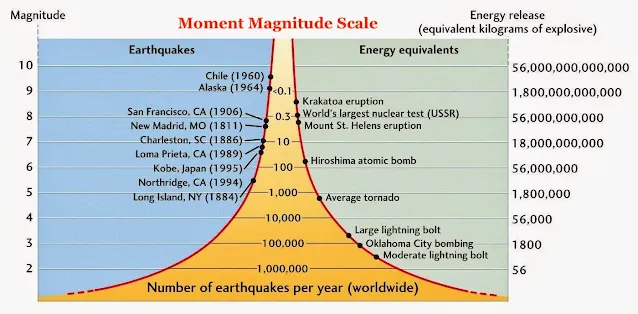Moment Magnitude Scale: Definition, Importance, Uses
How Do You Measure Earthquakes Using the Moment Magnitude Scale?
The moment magnitude scale (Mw) is a logarithmic scale used to measure the size of earthquakes. It is based on the seismic moment, which is a measure of the energy released by an earthquake. The seismic moment is calculated by multiplying the area of the fault that ruptured by the average amount of slip and the rigidity of the rock.
The MMS was developed in the 1970s by seismologists Hiroo Kanamori and Thomas C. Hanks, and it is now the standard scale used by seismological authorities to measure the magnitude of earthquakes. The MMS is more accurate than other magnitude scales, such as the Richter scale, for measuring the magnitudes of large earthquakes.
 |
| Moment Magnitude Scale |
The moment magnitude scale is the preferred magnitude scale for earthquakes of all sizes, but it is especially useful for measuring large earthquakes. This is because the moment magnitude scale is less likely to saturate than other magnitude scales, such as the Richter scale. This means that the moment magnitude scale can be used to measure the largest earthquakes without underestimating their magnitude.
The Mw scale is logarithmic, which means that each increase in one magnitude unit represents a tenfold increase in the seismic moment. For example, an earthquake with a magnitude of 7.0 has a seismic moment that is ten times greater than an earthquake with a magnitude of 6.0.
The Mw scale is a more accurate measure of the magnitude of large earthquakes than other scales, such as the Richter scale. This is because the Richter scale is based on the amplitude of seismic waves, which can be affected by the distance to the earthquake and the type of ground that the waves travel through. The Mw scale, on the other hand, is based on the seismic moment of the earthquake, which is not affected by these factors.
The Importance of the moment magnitude scale
The moment magnitude scale is an important tool for seismologists and other scientists who study earthquakes. It allows them to accurately measure the size of earthquakes and to compare earthquakes from different regions of the world.
The moment magnitude scale is also used by emergency managers and other government officials to assess the potential damage from an earthquake. It can help them to determine where to send resources and how to evacuate people from areas that are at risk.
The Differences Between the Richter Scale and the Moment Magnitude Scale
The Richter scale and the moment magnitude scale are both logarithmic scales used to measure the size of earthquakes. However, there are some key differences between the two scales.
Richter scale
The Richter scale was developed in 1935 by Charles F. Richter to measure the magnitude of earthquakes in southern California. It is based on the amplitude of the largest body wave recorded on a seismograph station located 100 kilometers from the epicenter of the earthquake.
The Richter scale is a local magnitude scale, which means that it is only accurate for measuring earthquakes that occur within a certain distance of the seismograph station. It is also not very accurate for measuring large earthquakes.
Richter Scale and the Moment Magnitude Scale
The main difference between the Richter scale and the moment magnitude scale is that the Richter scale is based on the amplitude of seismic waves, while the moment magnitude scale is based on the seismic moment of an earthquake. This difference means that the Richter scale is more sensitive to the distance from the epicenter and the type of soil than the moment magnitude scale.
Another difference between the Richter scale and the moment magnitude scale is that the Richter scale saturates at magnitudes above 7 or 8. This means that the Richter scale does not provide accurate estimates of the size of large earthquakes. The moment magnitude scale does not saturate, and it can be used to measure earthquakes of any size.
The following table summarizes the key differences between the Richter scale and the moment magnitude scale:
Richter Scale Vs Moment Magnitude Scale
| Characteristic | Richter Scale | Moment Magnitude Scale |
|---|---|---|
| Basis | Amplitude of the largest seismic wave recorded by a Wood-Anderson seismograph | Seismic moment of the earthquake |
| Type of scale | Local magnitude scale | Global magnitude scale |
| Accuracy | Best for small to moderate earthquakes | Accurate for measuring earthquakes of all sizes |
| Preferred scale | Used historically, but now superseded by the moment magnitude scale | Currently preferred scale for reporting earthquake magnitudes |
The moment magnitude scale is now the preferred scale for reporting earthquake magnitudes by the USGS and other scientific organizations.




%20(1).webp)



